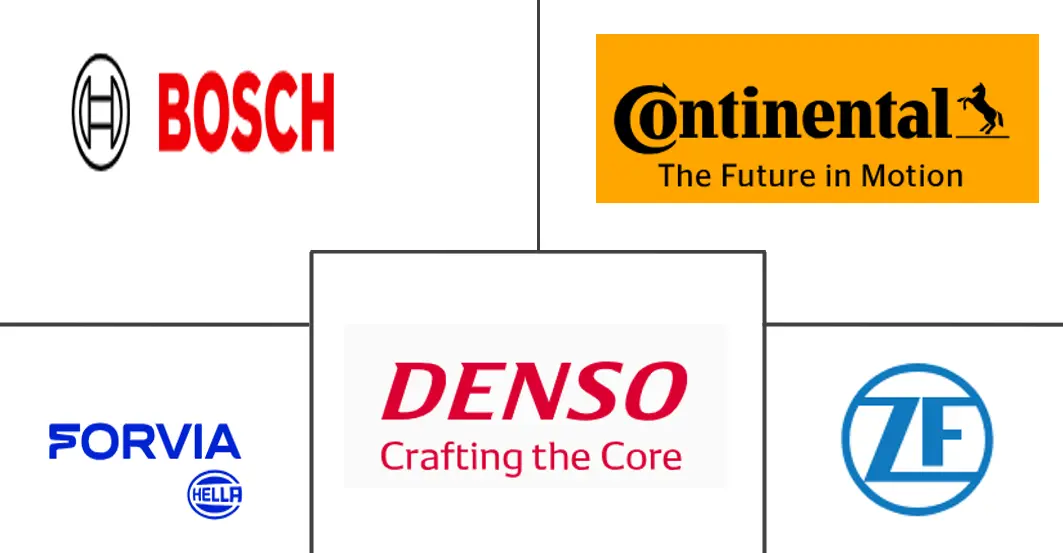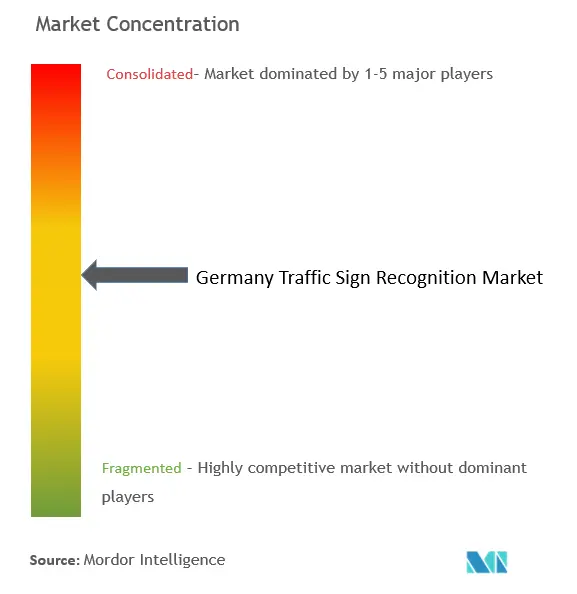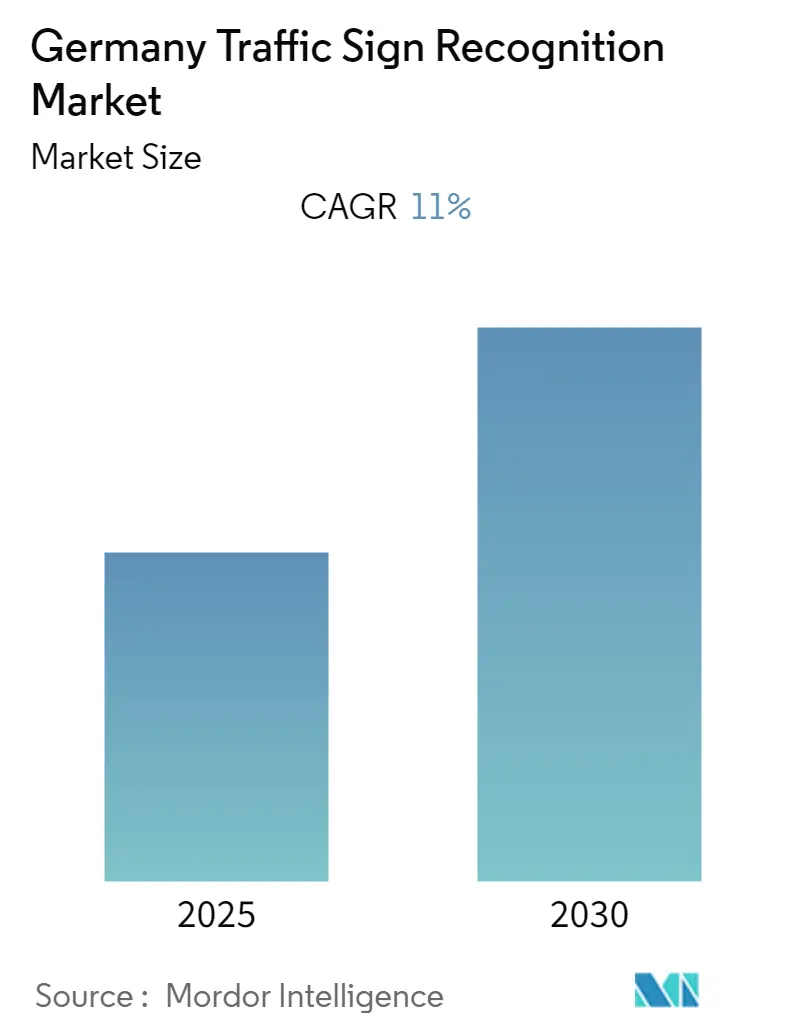
Germany Traffic Sign Recognition Market Analysis
The Germany Traffic Sign Recognition Market is expected to register a CAGR of 11% during the forecast period.
Over the medium term, Growing production of vehicles with integrated ADAS features in the wake of rising awareness toward the comfort and safety of passengers and government regulations mandating safety features are expected to drive demand in the market. Moreover, the rising acceptance of self-driving or automated vehicles further contributes to the enhanced growth of the market in the coming years.
With the increase in the convergence of sensor- and connectivity-based solutions, these systems are critical to making decisions based on information from the surrounding environment. In this respect, traffic sign recognition systems help to significantly reduce the burden on drivers, augment the safety aspects, and increase the driver's convenience, which in turn is anticipated to boost the market in coming years.
Stringent emission regulations, adoption of enhanced technologies for road safety, advancements in research into sensors, cameras, and other automobile technologies, and scaling of manufacturing of sensor-based technologies across the world are some of the drivers for traffic signal recognition-enabled vehicles.
The integration of modern safety and comfort features in vehicles, such as advanced driver assistance systems, vehicle infotainment, and many others, is increasing significantly in the market. Additionally, increased production of automobiles with integrated ADAS features in response to increased passenger comfort and safety awareness, as well as government legislation mandating safety measures, are expected to drive market demand. Furthermore, the growing acceptance of self-driving or automated vehicles contributes to the market's expansion during the forecast period.
Germany Traffic Sign Recognition Market Trends
Growing Demand For ADAS Features In Vehicles
Modern vehicles have become smarter and safer as more connected cars, autonomous cars, and ADAS are entering the market. The vehicle technologies that are presently available will soon be overlapped by new technologies that will require fewer human participants. Automotive companies are developing new and improved technologies to stay ahead in the market.
Rising traffic congestion and the adoption of ADAS in vehicles are expected to drive demand in the market. Furthermore, innovating technology for reading the signboards in harsh weather and obstructions is expected to be a key opportunity for players operating in the market.
Furthermore, innovating technology for reading the signboards in harsh weather and obstruction before traffic signs can be a good opportunity for the growth of the market. Looking at the expansion of these companies worldwide, companies are focusing on adopting various growth strategies to gain a competitive edge in the market. For instance,
- In March 2022, Acura announced the 2023 Integra with traffic sign recognition and traffic jam assist. The standard on every Integra is with rear cross-traffic monitoring.
As of mid-2022, all new cars put on the Europe market may have to be equipped with advanced safety systems. Following an agreement with the European Parliament in March 2021, the council adopted a regulation on the general safety of motor vehicles and the protection of vehicle occupants and vulnerable road users in a bid to significantly reduce the number of road casualties. Additionally, Euro NCAP, a government-backed group that rates cars for safety, may require cars to have a driver-monitoring system in order to earn a five-star safety rating starting in 2023 or 2024.
The above-mentioned development across the country is likely to witness major growth for the market during the forecast period.
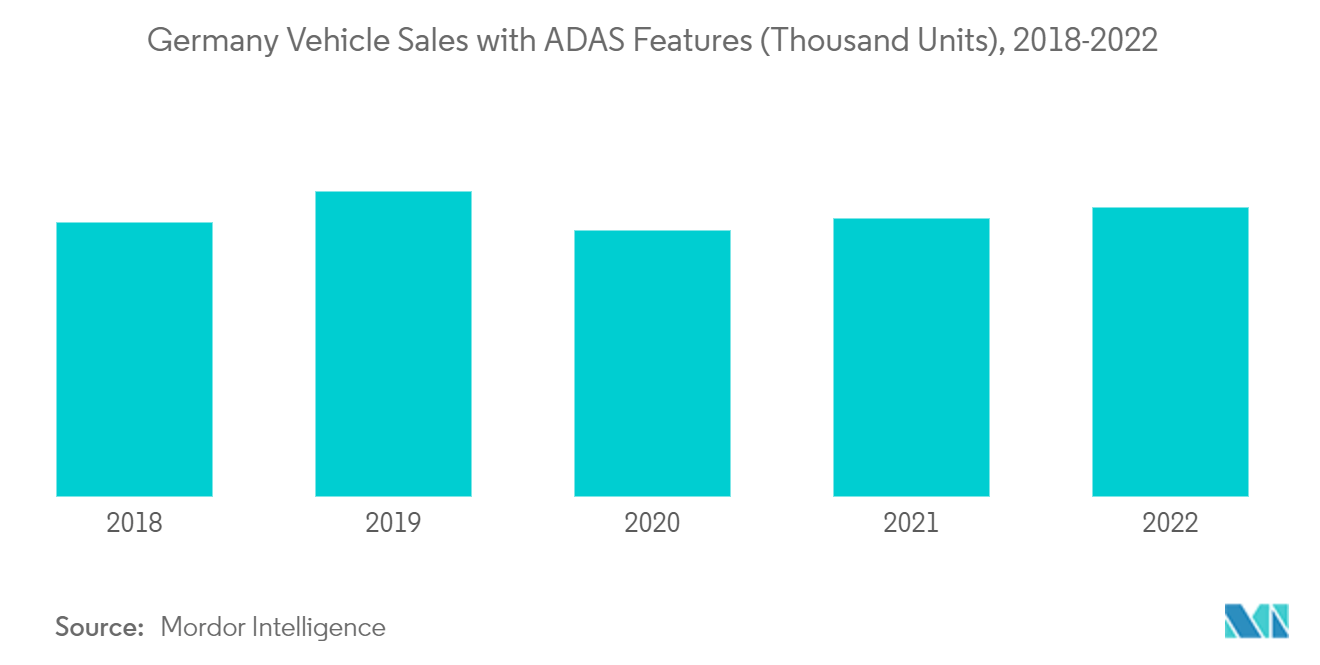
Growing Connected Vehicle Demand
Germany is one of the leading vehicle manufacturing countries across the globe. The country has the major presence of housing industry giants such as Volkswagen, Daimler-Mercedes, BMW, Porsche, etc.
The automotive industry in the country accounts for much of the R&D spending of the country, with a share of over 35%. Several presences of automotive tier-1 suppliers, such as Robert Bosch, Continental AG, and others across the country, are likely to witness major growth for the connected vehicle market during the forecast period.
Several key players are collaborating to develop advanced technologies for the vehicle, which will promote the connected vehicle platform across the country. For instance,
- In February 2023, dSPACE GmbH and B-Design3D collaborated to enable developers of autonomous vehicles to validate sensors and algorithms during virtual test drives in high-precision, three-dimensional, real-world environments, getting self-driving cars on the road faster. As part of the collaboration, dSPACE has integrated a new, 3-D urban environment produced by B-Design3D into the latest release of AURELION, dSPACE's solution for sensor-realistic simulation, allowing the integration of top-grade visualization and cutting-edge, realistic sensors into processes to develop and validate autonomous driving functions.
Rising demand for electric vehicles across the country is likely to create an opportunity for the market in the coming years. Several vehicle manufacturers are introducing new connected vehicle platforms, which are likely to enhance growth during the forecast period. For instance,
- In November 2022, Next.e.GO Mobile SE (e.GO), a producer of urban electric vehicles (EVs), partnered with connected vehicle platform company Sibros to deploy connected mobility solutions into its new vehicles across Germany.
- In September 2022, Vodafone launched the V2X platform in Germany. The new platform informs about the current safety and traffic information in real-time with cars.
- In June 2022, PATEO Corporation and Qualcomm Technologies, Inc. (Qualcomm) expanded their relationship to develop solutions to support vehicle intelligence, smart car connectivity, Service-Oriented Architecture (SOA), and intelligent cockpits and multi-domain fusion based on central controllers.
With the development mentioned above across the country, the market is witnessing major growth during the forecast period.
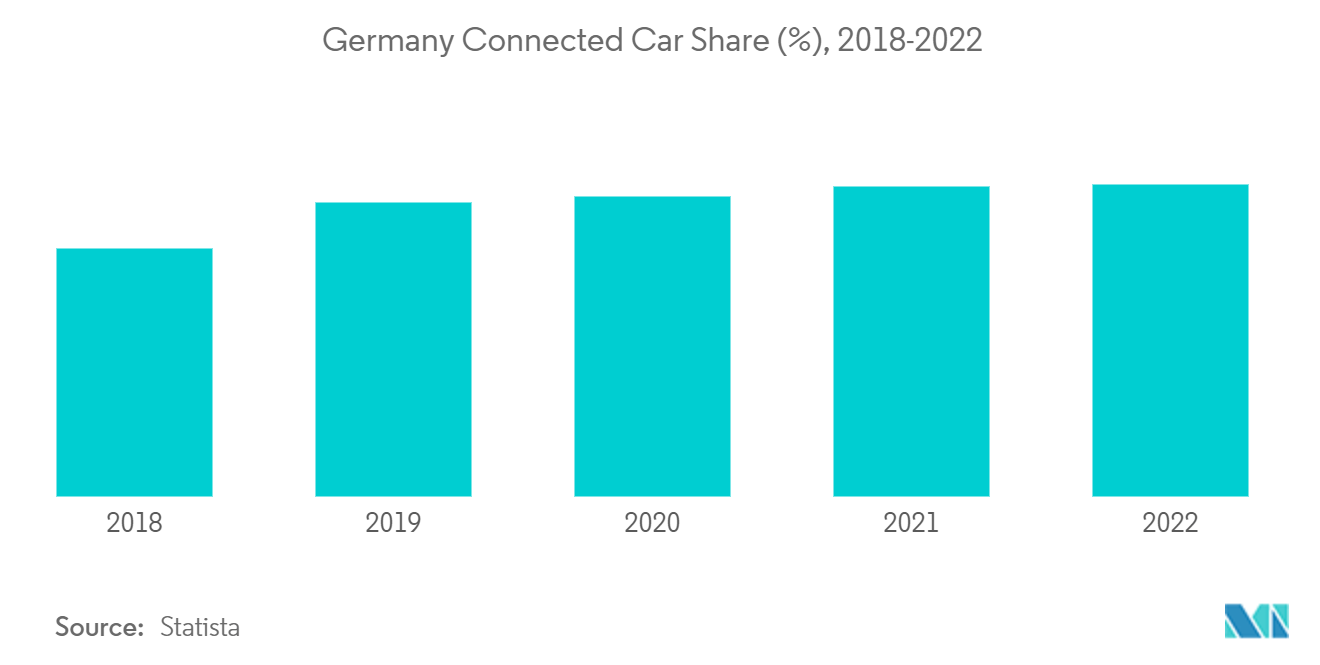
Germany Traffic Sign Recognition Industry Overview
Several key players, such as Robert Bosch Gmbh, DENSO Corporation, Continental AG, HELLA GmbH & Co. KGaA, and others, dominate the German traffic signal recognition market. Companies are introducing various new technologies and joining hands with other players to stay ahead in the market. For instance,
In April 2022, Solaris supplied a total of 10 hydrogen-powered buses in the Upper Bavaria region in Germany. The vehicle supports the driver with its additional functionalities, such as traffic sign recognition.
In August 2022, Stellantis introduced an electric van based on Opel Zafira's e-Life in Germany. The vehicle is equipped with features such as traffic sign recognition with semi-adaptive cruise control.
Germany Traffic Sign Recognition Market Leaders
-
Robert Bosch GmbH
-
Continental AG
-
HELLA GmbH & Co. KGaA
-
Denso Corporation
-
ZF Friedrichshafen AG
- *Disclaimer: Major Players sorted in no particular order
Germany Traffic Sign Recognition Market News
- May 2023: MAXUS, a subsidiary of the Chinese SAIC Group, introduced the all-electric MIFA 9 in Germany. The new model consists of major features such as a Cross-traffic alert with an integrated emergency braking function when reversing is always on board.
- May 2023: Mercedes-Benz Group AG introduced eCitan in the commercial van segment in Germany. The van has safety features like Speed Limit Assist with traffic sign recognition.
Germany Traffic Sign Recognition Industry Segmentation
Traffic signal recognition is a driver support function that is used to notify and warn the driver about the restrictions that are effective on the road. The German traffic signal recognition market is segmented into traffic sign detection type and vehicle type. Based on the traffic sign detection type, the market is segmented into color-based detection, shape-based detection, and feature-based detection. Based on the vehicle type, the market is segmented into passenger cars and commercial vehicles. For each segment, the market size and forecast have been done based on the value (USD).
| By Type | Color-based Detection |
| Shape-based Detection | |
| Feature-based Detection | |
| By Vehicle Type | Passenger Cars |
| Commercial Vehicles |
Germany Traffic Sign Recognition Market Research FAQs
What is the current Germany Traffic Sign Recognition Market size?
The Germany Traffic Sign Recognition Market is projected to register a CAGR of 11% during the forecast period (2025-2030)
Who are the key players in Germany Traffic Sign Recognition Market?
Robert Bosch GmbH, Continental AG, HELLA GmbH & Co. KGaA, Denso Corporation and ZF Friedrichshafen AG are the major companies operating in the Germany Traffic Sign Recognition Market.
What years does this Germany Traffic Sign Recognition Market cover?
The report covers the Germany Traffic Sign Recognition Market historical market size for years: 2019, 2020, 2021, 2022, 2023 and 2024. The report also forecasts the Germany Traffic Sign Recognition Market size for years: 2025, 2026, 2027, 2028, 2029 and 2030.
Our Best Selling Reports
Germany Traffic Sign Recognition Industry Report
Statistics for the 2025 Germany Traffic Sign Recognition market share, size and revenue growth rate, created by Mordor Intelligence™ Industry Reports. Germany Traffic Sign Recognition analysis includes a market forecast outlook for 2025 to 2030 and historical overview. Get a sample of this industry analysis as a free report PDF download.

